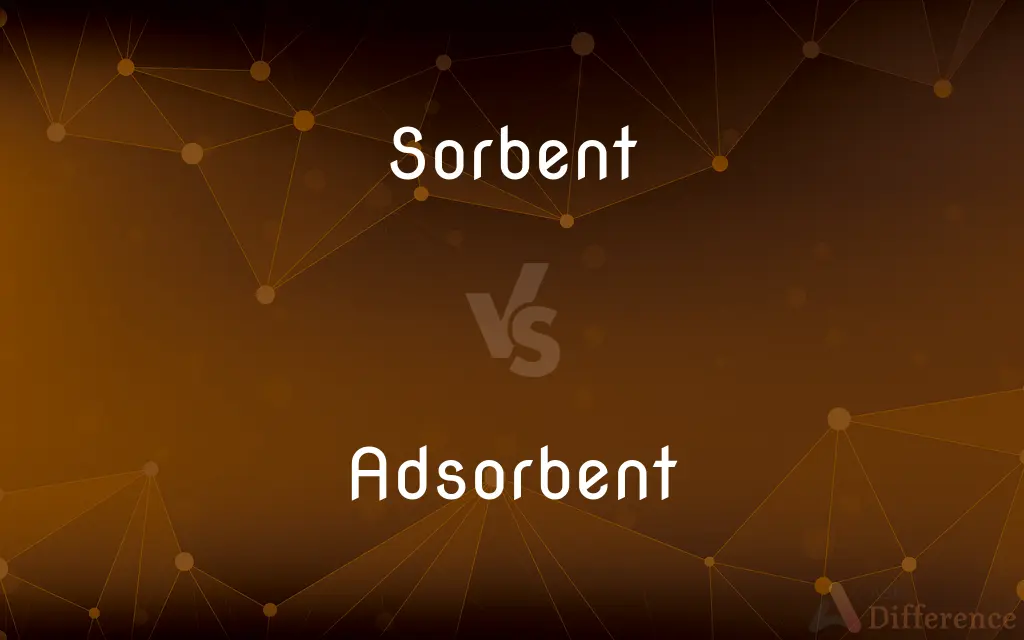Sorbent vs. Adsorbent — What's the Difference?
Edited by Tayyaba Rehman — By Fiza Rafique — Updated on March 26, 2024
Sorbents are materials that soak up liquids or gases, whereas adsorbents accumulate substances on their surface without absorption.

Difference Between Sorbent and Adsorbent
Table of Contents
ADVERTISEMENT
Key Differences
Sorbents and adsorbents, while both involved in the process of sorption, operate through fundamentally different mechanisms. Sorbents are a broad category of materials that include both absorbents and adsorbents, and they are used to soak up or accumulate liquids or gases. The key distinction lies in how the substances are captured: sorbents can either absorb—where the material takes up another substance internally—or adsorb, where the substance is collected on the surface of the material. On the other hand, adsorbents are specifically designed to attract and hold particles on their surface without incorporating them into their internal structure.
The effectiveness of sorbents and adsorbents is determined by their porosity, surface area, and chemical properties. Sorbents, in general, can vary widely in their composition and can be organic, like cellulose, or inorganic, like silica gel. They are chosen based on the specific needs of a task, such as oil spill cleanup, where a material's ability to absorb large quantities of liquid is crucial. Adsorbents, however, are particularly valued for their high surface area and porosity, making them ideal for applications requiring the removal of contaminants or chemicals from air or water, such as activated carbon used in water filtration systems.
In practical applications, the choice between using a sorbent and an adsorbent depends on the nature of the material to be removed and the desired outcome of the sorption process. Sorbents that absorb are preferred when the goal is to remove a substance from an environment completely, as they can take up and contain spills or leaks. Adsorbents are chosen for scenarios where the selective removal of certain chemicals or gases is necessary, as they can target specific substances for capture on their surface.
From an environmental and sustainability perspective, the reusability and disposal of sorbents and adsorbents are important considerations. Sorbents that absorb pollutants or contaminants may become hazardous waste themselves, requiring careful disposal. Adsorbents, however, often offer the possibility of regeneration, allowing them to be cleaned and reused multiple times, which can be a significant advantage in reducing waste and operational costs.
Technological advancements continue to refine the capabilities and applications of both sorbents and adsorbents. Innovations in materials science are expanding the efficiency and selectivity of adsorbents, making them more effective in capturing specific pollutants at the molecular level. Similarly, developments in sorbents are enhancing their capacity to absorb larger volumes of liquid or gas, improving their utility in emergency response and industrial processes.
ADVERTISEMENT
Comparison Chart
Mechanism
Can absorb (internal uptake) or adsorb (surface collection)
Specifically collects substances on its surface
Composition
Can be organic or inorganic
Often high in surface area and porosity
Applications
Broad, including liquid spills and gas capture
Focused on selective removal of contaminants or chemicals
Example Uses
Oil spill cleanup, water remediation
Water filtration, air purification
Environmental Consideration
May require disposal as hazardous waste
Can often be regenerated and reused
Compare with Definitions
Sorbent
General term for materials that soak up liquids or gases.
Sorbents are used in environmental cleanups to absorb oil spills.
Adsorbent
Characterized by high surface area and porosity.
The effectiveness of an adsorbent like silica gel in drying applications is due to its large surface area.
Sorbent
Includes both absorbent and adsorbent materials.
Sorbents can either absorb pollutants within their structure or adsorb them on the surface.
Adsorbent
Materials that capture substances on their surface.
Activated carbon, a common adsorbent, is used in water filters to remove toxins.
Sorbent
Used in a wide range of applications.
Sorbents are crucial in industrial, environmental, and emergency response settings.
Adsorbent
Selectively removes specific contaminants.
Adsorbents are used in air purifiers to selectively remove harmful gases and pollutants.
Sorbent
Varied composition, depending on the application.
Organic sorbents like cellulose are used for their ability to biodegrade.
Adsorbent
Often reusable through regeneration.
Many adsorbents can be cleaned and reused, making them a sustainable option for environmental management.
Sorbent
Disposal and environmental impact vary.
The use of sorbents in oil spill cleanup requires careful disposal to prevent environmental harm.
Adsorbent
Advancements improve efficiency and selectivity.
Research is focused on developing new adsorbents that can target and remove specific pollutants from water and air.
Sorbent
A sorbent is a material used to absorb or adsorb liquids or gases. Examples include: A material similar to molecular sieve material, which acts by adsorption (attracting molecules to its surface).
Adsorbent
Capable of adsorption.
Sorbent
To take up and hold, as by absorption or adsorption.
Adsorbent
An adsorptive material, such as activated charcoal.
Sorbent
(sciences) A substance that can enable sorption.
Adsorbent
Tending to adsorb.
Sorbent
An absorbent.
Adsorbent
The solid or liquid in the process of adsorption on which the adsorbate accumulates.
Sorbent
A material that sorbs another substance; i.e. that has the capacity or tendency to take it up by either absorption or adsorption
Adsorbent
A material having capacity or tendency to adsorb another substance
Adsorbent
Having capacity or tendency to adsorb or cause to accumulate on a surface
Common Curiosities
What makes an adsorbent effective?
The effectiveness of an adsorbent is largely determined by its surface area, porosity, and the chemical properties that allow it to selectively bind with certain substances.
What is the key difference between a sorbent and an adsorbent?
The key difference is that sorbents can absorb or adsorb substances, while adsorbents specifically capture substances on their surface.
How do you choose between a sorbent and an adsorbent for a specific application?
The choice depends on the nature of the substance to be removed and the context of its removal. For bulk liquid spills, absorbents are preferred, whereas for selective removal of pollutants from air or water, adsorbents like activated carbon are more effective.
What is the difference between physical and chemical adsorption?
Physical adsorption (physisorption) involves the accumulation of substances on the adsorbent’s surface through weak Van der Waals forces, whereas chemical adsorption (chemisorption) involves stronger chemical bonds between the substance and the adsorbent.
Can adsorbents be reused?
Yes, many adsorbents can be regenerated and reused, offering an environmentally friendly and cost-effective solution for pollution control.
What are some common materials used as adsorbents?
Common adsorbents include activated carbon, silica gel, zeolites, and various metal-organic frameworks (MOFs) designed for high specificity in pollutant capture.
Can sorbents and adsorbents be used together?
Yes, in many environmental and industrial processes, a combination of sorbents and adsorbents is used to maximize the removal of a wide range of pollutants, leveraging the strengths of each.
How do sorbents help in environmental cleanup?
Sorbents, including both absorbents and adsorbents, are used to remove pollutants from water and soil, aiding in the cleanup of oil spills and chemical leaks.
Are all sorbents biodegradable?
Not all sorbents are biodegradable. The biodegradability of a sorbent depends on its material composition, with organic sorbents being more likely to biodegrade than inorganic ones.
How are used adsorbents regenerated?
Used adsorbents can often be regenerated through processes such as thermal desorption, where the adsorbed material is removed by heating, or chemical treatment, which removes the adsorbed substances and restores the adsorbent’s capacity.
What are some common materials used as sorbents?
Common sorbents include organic materials like peat moss and cotton, inorganic materials like clay and silica gel, and synthetic materials like polypropylene.
What role do pore size and surface area play in adsorption?
The pore size and surface area of an adsorbent are critical factors that determine its adsorption capacity. Larger surface areas and appropriate pore sizes enable more molecules to be captured on the adsorbent’s surface.
How do temperature and pressure affect adsorption?
Adsorption processes are generally affected by temperature and pressure; increasing pressure tends to increase adsorption until saturation, while increasing temperature may decrease adsorption in physical adsorption processes but can have variable effects on chemical adsorption.
How is the efficiency of an adsorbent measured?
The efficiency of an adsorbent is typically measured by its adsorption capacity, which is the amount of a specific substance it can adsorb per unit weight or volume, and its selectivity, or its ability to preferentially adsorb certain substances in the presence of others.
Are there environmental concerns associated with the use of sorbents and adsorbents?
Yes, the disposal of used sorbents and adsorbents, especially those contaminated with hazardous substances, can pose environmental risks. Additionally, the production of some adsorbents, like activated carbon, can have a significant environmental footprint.
Share Your Discovery

Previous Comparison
Volume vs. Book
Next Comparison
Liberalism vs. CapitalismAuthor Spotlight
Written by
Fiza RafiqueFiza Rafique is a skilled content writer at AskDifference.com, where she meticulously refines and enhances written pieces. Drawing from her vast editorial expertise, Fiza ensures clarity, accuracy, and precision in every article. Passionate about language, she continually seeks to elevate the quality of content for readers worldwide.
Edited by
Tayyaba RehmanTayyaba Rehman is a distinguished writer, currently serving as a primary contributor to askdifference.com. As a researcher in semantics and etymology, Tayyaba's passion for the complexity of languages and their distinctions has found a perfect home on the platform. Tayyaba delves into the intricacies of language, distinguishing between commonly confused words and phrases, thereby providing clarity for readers worldwide.















































